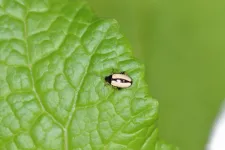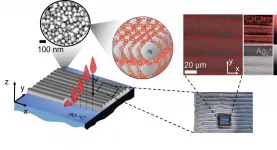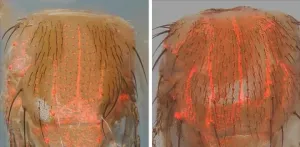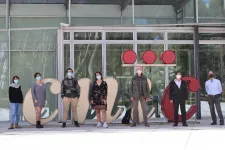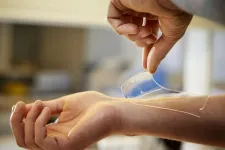(Press-News.org) When horseradish flea beetles feed on their host plants, they take up not only nutrients but also mustard oil glucosides, the characteristic defense compounds of horseradish and other brassicaceous plants. Using these mustard oil glucosides, the beetles turn themselves into a "mustard oil bomb" and so deter predators. A team of researchers from the Max Planck Institute for Chemical Ecology in Jena, Germany, has now been able to demonstrate how the beetle regulates the accumulation of mustard oil glucosides in its body. The beetles have special transporters in the excretory system that prevent the excretion of mustard oil glucosides. This mechanism enables the horseradish flea beetle to accumulate high amounts of the plant toxins in its body, which it uses for its own defense (Nature Communications, May 2021, doi: 10.1038/s41467-021-22982-8).
Sequestration: Well armed with the weapons of others
Many animals use chemical defense compounds to deter predators. These defense compounds are either produced by the animal itself or by symbionts of the animal, or they are acquired from the diet. The ability to acquire defense compounds from the diet is particularly widespread in insects that feed on toxic plants. One example is the horseradish flea beetle (Phyllotreta armoraciae), which can sequester mustard oil glucosides, also known as glucosinolates, in its body.
"The horseradish flea beetle belongs to an economically important group of insects, because several Phyllotreta species are crop pests. This beetle, which can accumulate vast amounts of host plant glucosinolates, regulates the levels and composition of glucosinolates in the body at least partially by excretion. This suggested that Phyllotreta armoraciae possesses very efficient transport and storage mechanisms, which we wanted to uncover," says first author Zhi-Ling Yang, explaining the goal of the new study.
The team led by Franziska Beran, head of the Sequestration and Detoxification in Insects Research Group at the Max Planck Institute, has already been able to demonstrate how the horseradish flea beetle effectively uses glucosinolates from its host plant to defend itself against a predatory ladybug (see press release, "Whether horseradish flea beetles can deter predators depends on their food plant and their life stage," March 2, 2020).
Special transporters for plant toxins in the excretory system of the beetles
Although it has long been known that horseradish flea beetles and related species can accumulate glucosinolates, how the beetle absorb and store high amounts of these substances in the body was unknown. The research team's goal, therefore, was to identify glucosinolate transporters in this insect. "The search for these transporters was literally like looking for a needle in a haystack," recalls Beran, "We found 1401 putative membrane transporters in the gut and excretory system of this beetle. Narrowing down our search to transporters that are specific for the horseradish flea beetle helped us to identify a group of glucosinolate-specific transporters."
These glucosinolate transporters are located in the excretory system, the so-called Malpighian tubules. The function of the Malpighian tubules in insects is similar to the function of the kidneys in vertebrates. The scientists determined the function of the identified transporters by using RNA interference, an approach in which the expression of a gene of interest is reduced in order to determine its function in the organism: "We silenced the expression of several transporter genes that are localized in the Malpighian tubules and found that the beetles excreted more glucosinolates than a control group of beetles with normal gene expression. Because of the higher excretion rate, the levels of defense compounds in the beetle body went down. Our study is the first to identify transporters in the Malpighian tubules that enable an insect to accumulate plant defense compounds," Yang summarizes.
With their study, the researchers show that sequestration is a complex process and much more than just the uptake of plant metabolites into the animal's body. The sequestering insect must adapt its entire physiology to use plant defense compounds for its own defense. These adaptations are driven by challenges in its environment: predators, parasites, and pathogens. "Sequestration is probably one of the most complex adaptations that herbivorous insects have evolved. It most certainly also contributes to the evolutionary success of insects that specialize in certain host plants, such as the horseradish flea beetle," says Beran.
Beran's team now wants to identify other transporters involved in sequestration. The scientists also want to know which natural enemies of the horseradish flea beetle the glucosinolates are providing protection from. Increased knowledge of how the horseradish flea beetle sequesters toxins and the effects on its ecological interactions with other organisms in the environment, will improve understanding of this pest and may lead eventually to better strategies for its control.
INFORMATION:
Original publication:
Yang, Z.-L., Nour-Eldin, H. H., Hänniger, S., Reichelt, M., Crocoll, C., Seitz, F., Vogel, H., Beran, F. (2021). Sugar transporters enable a leaf beetle to accumulate plant defense compounds. Nature Communications, doi: 10.1038/s41467-021-22982-8
Inks containing metal nanoparticles are among the most commonly-used conductive materials for printed electronics. Ink-jetting layers of MNP materials allows for unpreceded design flexibility, rapid processing and 3D printing of functional electronic devices such as sensors, solar panels, LED displays, transistors and smart textiles.
Inkjet 3D printing of metals typically form a solid printed object via a two-step process: solvent evaporation upon printing (pinning) and subsequent low-temperature consolidation of nanoparticles (sintering). The low temperature is important as in many applications the nanoparticles are co-printed with ...
Researchers at the University of California San Diego have laid the groundwork for a potential new type of gene therapy using novel CRISPR-based techniques.
Working in fruit flies and human cells, research led by UC San Diego Postdoctoral Scholar Zhiqian Li in Division of Biological Sciences Professor Ethan Bier's laboratory demonstrates that new DNA repair mechanisms could be designed to address the effects of debilitating diseases and damaged cell conditions.
The scientists developed a novel genetic sensor called a "CopyCatcher," which capitalizes on CRISPR-based gene drive technology, to detect instances in which a genetic element is copied precisely from one chromosome to another throughout cells in ...
Researchers at the University of Bristol have discovered how microbes responsible for human African sleeping sickness produce sex cells.
In these single-celled parasites, known as trypanosomes, each reproductive cell splits off in turn from the parental germline cell, which is responsible for passing on genes. Conventional germline cells divide twice to produce all four sex cells - or gametes - simultaneously. In humans four sperms are produced from a single germline cell. So, these strange parasite cells are doing their own thing rather than sticking to ...
Every high-school physics student learns that sound and light travel at very different speeds. If the brain did not account for this difference, it would be much harder for us to tell where sounds came from, and how they are related to what we see.
Instead, the brain allows us to make better sense of our world by playing tricks, so that a visual and a sound created at the same time are perceived as synchronous, even though they reach the brain and are processed by neural circuits at different speeds.
One of the brain's tricks is temporal recalibration: ...
A novel technique for studying vortices in quantum fluids has been developed by Lancaster physicists.
Andrew Guthrie, Sergey Kafanov, Theo Noble, Yuri Pashkin, George Pickett and Viktor Tsepelin, in collaboration with scientists from Moscow State University, used tiny mechanical resonators to detect individual quantum vortices in superfluid helium.
Their work is published in the current volume of Nature Communications.
This research into quantum turbulence is simpler than turbulence in the real world, which is observed in everyday phenomena such as surf, fast flowing rivers, billowing storm clouds, or chimney smoke. Despite ...
Scientists at the Centro Nacional de Investigaciones Cardiovasculares Centro de Biología Molecular Severo Ochoa (CBM-CSIC-UAM) have discovered that the nitric oxide (NO) pathway is overactivated in the aortas of mice and patients with Marfan Syndrome and that the activity of this pathway causes the aortic aneurysms that characterize this disease.
The results of the study, published today in Nature Communications, reveal the essential role played by NO in Marfan Syndrome aortic disease and identify new therapeutic targets and markers of NO pathway activation that could be used to monitor disease status and progression.
Aortic aneurysm ...
A new paper in the Journal of the European Economic Association, published by Oxford University Press, indicates that distrust generated by a 2011 CIA-led vaccination campaign ruse designed to catch Osama Bin Laden resulted in a significant vaccination rate decline in Pakistan.
Using a local doctor, the US Central Intelligence Organization planned an immunization plan in Pakistan to obtain DNA samples of children living in a compound in Abbottabad where American authorities suspected Bin Laden was hiding in order to obtain proof of Bin Laden's location (because the presence of close ...
About 42% of rural school districts in the U.S. offered fully in-person instruction as of February, compared with only 17% for urban districts, according to a new RAND Corporation survey of school district leaders. The opposite pattern held for fully remote learning: 29% of urban districts offered fully remote instruction compared with 10% of rural districts and 18% of suburban districts.
The choice of in-person versus remote learning has important implications. Over a third of all U.S. school districts offering some form of remote instruction in early 2021 had shortened the school day, and a quarter had reduced instructional minutes.
"This survey shows how the choice of remote instruction has ramifications that extend beyond longstanding concerns about ...
Aqueducts are very impressive examples of the art of construction in the Roman Empire. Even today, they still provide us with new insights into aesthetic, practical, and technical aspects of construction and use. Scientists at Johannes Gutenberg University Mainz (JGU) investigated the longest aqueduct of the time, the 426-kilometer-long Aqueduct of Valens supplying Constantinople, and revealed new insights into how this structure was maintained back in time. It appears that the channels had been cleaned of carbonate deposits just a few decades before the ...
Researchers at Chalmers University of Technology, Sweden, have developed a new material that prevents infections in wounds - a specially designed hydrogel, that works against all types of bacteria, including antibiotic-resistant ones. The new material offers great hope for combating a growing global problem.
The World Health Organization describes antibiotic-resistant bacteria as one of the greatest threats to global health. To deal with the problem, there needs to be a shift in the way we use antibiotics, and new, sustainable medical technologies must be developed.
"After testing our new hydrogel on different types of bacteria, we observed a high level of effectiveness, including against those ...
